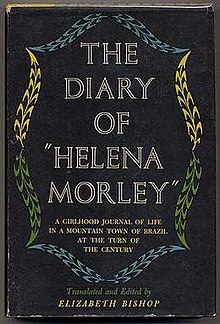|
Alice Dayrell Caldeira Brant
Alice Dayrell Caldeira Brant (August 28, 1880 – June 20, 1970) was a Brazilian juvenile writer. When she was a teenager, she kept a diary, which describes life in Diamantina, Minas Gerais, Brazil[1][2] which was then published in 1942. The diary was published under a pen name Helena Morley.[2][1] When it was originally published it was in portuguese under the title Minha Vida de Menina.[2] The diary was then translated in to English by Elizabeth Bishop in 1957.[1] Biography She was born in Diamantina, Minas Gerais, Brazil to an English father and a Brazilian mother.[3] Her father worked as a diamond miner.[4] The diary chronicles Brant's daily life, and covers her teenage years until 1895.[5] In 1900 Brant married Augusto Mário Calderia Brant, they had five children together.[3] Brant says that she published her diaries in order to act as a role model for younger females who may read the book.[6] She wrote that the diary was a way to show young women what becoming an adult means, and in this way she is acting like a grandmother to the reader.[6] One of her daughters, Ignez Caldeira Brant, married with Abgar Renault, Brazilian Ministry of Education (1955-1956) and of the federal accountability office, Tribunal de Contas da União (1967-1973).[7] Published workBrant's only published work is The Diary of Helena Morley, which she began writing when she attended the Normal School.[4] The diary discusses her daily life in the diamond mining town of Diamantina, romantic interests, but it also deals with heavier topics like loss.[8] The book also discusses relationships, marriage in particular, but also social affairs and Brant's dreams.[9] The topics of the book make it so that it could be a diary of a present day teenager rather than one 60 years ago.[5] Since Brant discusses her everyday life, insights about that point in history are able to be gained by reading the diary, particularly about the effects of the abolition of slavery.[10] There is very little documentation about life post emancipation, making the diary an important resource for historians.[11] Brant is praised for her ability to add humor to the discussion of racism, which typically is associated with seriousness.[12] Another reason Brant's book was so popular is the nostalgic that it brings the reader, the provincial life of a small town, that the reader is able to find peace in the description of the simple life.[6] ReceptionThe book attracted attention like many other diaries of young women.[10] The prevalence of young female diaries is explained for many of the same reasons Brant's own diary is popular.[6][10] That they allow the reader to feel young again and reminisce about when they were a teenager.[10][6] Some of the first attention that was drawn to Brant for her work was after Alexandre Eulálio praised Brant for her work these praises placed Brant among classic Brazilian authors.[6] French author Georges Bernanos also made the public aware of the book.[11] Elizabeth Bishop was originally drawn to the work in 1952, then in 1957 Bishop published her English translation of the book.[4] Bishop says that she was drawn to Brant's work because of Brant's impressive skills of observation and ability to recreate a scene using only words.[4] Some have compared Brant's work to Jane Austen that even though she was from a small town in Brazil, its style is like work from England.[9] References
External links
|
||||||||||||||||
